
Wine Culture and Information since 2002 - Volume 22
 Wine Culture and Information since 2002 - Volume 22 |
|
Comparing Pinot NoirThe magnificent red grape from Burgundy, capable of producing wines of rare elegance and class, is the protagonist of this month's comparative tasting |
|
Ladies and gentlemen, welcome to the world of elegance and of finesse. Although this introduction could not be agreed by many, it is however certain Pinot Noir is a grape capable of producing wines of which there is a lot to say, good things and bad ones. Pinot Noir - the renowned grape from Burgundy, France - has the fault of not being capable of staying “in the middle” of consumers' choices: it is a grape you love, or you can be completely indifferent to it. Nevertheless, this grape, in its best representations, is capable of producing wines of great elegance, class and finesse, maybe like few others in the world. Grape extremely versatile and, above all, hard to cultivate, Pinot Noir allows the creation of interesting white wines - by paying attention of removing skins soon after crushing - and it is present in almost all classic method sparkling wines, including the famous Champagne. The origins of Pinot Noir are very ancient - it is believed it is present in Burgundy for more than 2,000 years - and it is the protagonist of red wines in Côte d'Or, in particular the ones of Côte de Nuits. A grape being difficult to cultivate and to vinify, Pinot Noir - in the best cases - is however capable of making exceptional wines. If it is true young wines produced with this grape have “simple” aromas of red berried fruits - in particular cherry, raspberry, strawberry and plum - with time they get very complex and pleasing organoleptic qualities of chocolate, game, prune, truffle and, sometimes, smoked hints. However Pinot Noir is a grape which does not give that much in case it is being cultivated in areas with a non favorable climate or with deprecable qualitative criteria. This is the main factor which leaves wine lovers perplexed and the ones who do not like this grape. The difference between great Pinot Noirs and mediocre ones is in fact remarkable and tasting a low quality Pinot Noir it is not amazing, even because the typical tricks used in cellar to make a wine better than it really is, do not help that much.
|
|
The goal of our comparative tasting is to understand the main organoleptic qualities of Pinot Noir according to the wine making techniques used for the production of the three wines. Pinot Noir is a grape which likes cool climate areas and does not like the warm ones much. Despite the homeland of Pinot Noir is Burgundy, in particular the Côte d'Or, this grape is also cultivated in other areas of the world and - in favorable climate conditions - can give good examples of wines even outside the borders of France. Because of its particular organoleptic qualities, the vinification of Pinot Noir hardly makes use of an invasive aging in barrique or other wood containers. Despite barrique and cask are frequently used in the vinification of Pinot Noir, the most common choice, as well as more appropriate, is represented by the use of non excessively toasted wood, in order to keep the integrity and identity of its organoleptic qualities.
The wines selected for this month's comparative tasting are from three different areas of Italy, three good representatives of Italian Pinot Noirs. The first wine selected is Produttori Termeno's Alto Adige Pinot Nero Schiesstandhof. This wine is produced with 100% Pinot Noir and aged for 9 months in barrique, followed by a further aging in cask. The second wine is Ca' del Bosco's Pinèro, a famous winery for the production of excellent Franciacorta. Pinèro ages for 13 months in barrique. The third and last wine of our comparative tasting is Ruffino's Nero al Tondo, an excellent wine produced in Tuscany and aged in barrique for 12 months. As the three wines are generally commercialized some years after harvesting, it will be appropriate to use a serving temperature of 18°C (64°F) in all the three cases. Despite Pinot Noir produces wines with an appreciable crispness, aging, in this case, gives a pleasing roundness which will be properly valued by temperature. Our tasting will be done by using three ISO tasting glasses.
|
||||||||
|
Pinot Noir is a grape not very rich in colorant substances, therefore it is pretty unlike to see wines produced with this grape showing intense and deep colors - such as in case of Cabernet Sauvignon - and its appearance always shows a moderate transparency. Because of a deprecable “culture”, in which it is believed a red wine, in order to be good and of quality, must always show intense and deep colors with impenetrable transparencies, Pinot Noir is frequently discriminated because it does not seem to confirm this theory in most of the cases. After all, if wine would just be what we can see, it would really take a little to make a great wine. However, wines produced with Pinot Noir show pretty variable transparencies, sometimes pretty low as well, a condition which is - as always - determined by the quality of grapes, production area and the techniques used in vinification. The first wine we are going to evaluate is Produttori Termeno's Alto Adige Pinot Nero Schiesstandhof. By holding the glass tilted over a white surface, it will be observed the intensity of the color at the base of the glass. It will be noticed a brilliant ruby red color and, near the border of the liquid mass, towards the opening of the glass, it will be observed nuances of garnet red. The second wine of which we will evaluate appearance is Ruffino's Nero al Tondo. The color of this wine is intense ruby red and - just like for the previous wine - with garnet red nuances. We will now evaluate the last wine, Ca' del Bosco's Pinèro. Just like in the previous wines, the color of Pinèro is brilliant ruby red and, as opposed to the other wines, it shows ruby red nuances instead of garnet ones. It will also be noticed how in all the three wines the transparency is pretty moderate, therefore confirming the non high contents in colorant substances in Pinot Noir.
|
|
One of the most fascinating qualities of Pinot Noir is represented by its aromas. Fresh and fruity, as well as rich and complex, wines produced with Pinot Noir express an elegance and finesse of aromas making them unique. Of course these are qualities which is possible to find in all good wines, however in Pinot Noir have a cleaner and very elegant impact. Even the proper use of barrique and cask contribute to the best expression of the aromatic qualities of red wines from Pinot Noir. Despite it is undeniable the use of wood containers for the aging of wines play an important role, a correct and non invasive use represent in Pinot Noir the best choice. A strong use of barrique in wines produced with this grape would exalt strong wood aromas, while completely covering the finesse and freshness of its aromas. Even for this reason, Pinot Noir is sometimes vinified by using inert container, such as stainless steel or cement. The first wine of which we will evaluate aromas is Produttori Termeno's Alto Adige Pinot Nero Schiesstandhof. By keeping the glass still and in vertical position, we will begin by evaluating opening aromas. The first smell will allow the perception of aromas of cherry and raspberry, two aromas typically found in Pinot Noir wines, in particular cherry. After having swirled the glass, in order to favor a proper oxygenation of the wine, a second smell will be done. It will be possible to perceive from the glass aromas of strawberry, plum, dried rose and geranium as well as tertiary aromas developed from the aging in wood, in particular vanilla, licorice and cocoa. It should be noticed how the aroma of vanilla - typical in wines aged in cask - is pretty limited and balanced, while leaving the right opportunity to the fruity nature of wine to develop, very agreeable. The second wine we are going to evaluate is Ruffino's Nero al Tondo. By holding the glass still and in vertical position, we will proceed with the evaluation of opening aromas. Just like for the previous wine, even in Nero al Tondo it will be perceived aromas of cherry and raspberry, followed by aromas of plum. The second smell - done after having swirled the glass - will allow the perception of strawberry, blueberry and rose as well as a tertiary aromatic sequence, more complex than the previous wine, of licorice, vanilla, tobacco, chocolate, leather, pink pepper and mace. We will now examine Ca' del Bosco's Pinèro, in which it will be possible to perceive opening aromas of cherry, raspberry, plum and blueberry. After having swirled the glass, the aromatic sequence will be completed by aromas of rose and hints of black currant, followed by chocolate, coffee, eucalyptus, vanilla, smoked and hints of black pepper.
|
||||
|
The elegance of Pinot Noir continues to be expressed even in taste. Just like for aromas, the taste of Pinot Noir are characterized by elegant and refined qualities, well supported by its typical crispness. One of the main characteristic of Pinot Noir is in fact acidity that - together with its low content in tannins - make the organoleptic profile of these wines pretty special. However this acidity has some drawbacks, because when it is excessively exalted, it makes the wine unbalanced. Even the low content in tannins of Pinot Noir can be properly balanced thanks to an intelligent aging of the wine in cask or in barrique, while paying attention to not exaggerate on this aspect as this would tend to excessively cover the nature of Pinot Noir. Quality Pinot Noir wines require practice and competence in every phase of the production, from the cultivation of grapes to bottling. The fame of being a difficult grape is certainly true, however this “bizarre” red grape is capable of making extraordinary wines even in taste. The first wine we are going to evaluate is Produttori Termeno's Alto Adige Pinot Nero Schiesstandhof. It should be noticed how the crispness in the attack is pretty evident, however well balanced, something which is different from the typical model of red wine, such as the ones produced with Merlot. It should also be noticed the appreciable astringency, a contribution of the aging in cask - certainly not aggressive and strong, such as in case of Cabernet Sauvignon - however in logic balance with all the other organoleptic qualities. Let's now evaluate Ruffino's Nero al Tondo. Even in this case in the attack is perceived a good crispness and, as opposed to the previous wine, a higher astringency, even in this case, accentuated by the aging in barrique. The last wine to be evaluated is Ca' del Bosco's Pinèro. Even in this case crispness is pretty evident, well balanced by alcohol, just like the previous wines, and astringency caused by tannins is well perceptible as well. It should be noticed, in all the three wines, how the use of cask is very balanced as to allow the appreciation of fruity and flowery qualities of Pinot Noir.
|
|
The three Pinot Noirs of our comparative tasting allowed us to well understand the organoleptic qualities of this grape, as well as the influence of cask and its use. The finish of Produttori Termeno's Alto Adige Pinot Nero Schiesstandhof is persistent, leaving in the mouth pleasing flavors of cherry, raspberry and strawberry, three aromatic qualities typical in Pinot Noir. The finish of Ruffino's Nero al Tondo is persistent as well and characterized by flavors of cherry, raspberry and strawberry, just like the previous wine. The finish of the last wine, Ca' del Bosco's Pinèro, will be persistent with flavors of cherry, blueberry and plum. It should be noticed the aromas and flavors of cherry, as well as raspberry and strawberry, are recurrent qualities of Pinot Noir - such as in the case of our three wines - and the floral qualities usually recall rose and cyclamen. The secret for making a good Pinot Noir, just like in the case of our three wines, is the use of quality grapes - a factor which certainly is determinant for every wine - and that in Pinot Noir represents a further difficulty. Finally, it should be noticed that, despite it is important in the balance and structure of wine, in Pinot Noir the use of cask and barrique will never be excessive, in order to allow the grape to express its elegance.
|
Wines of the Month |
|
|
|
Score legend Prices are to be considered as indicative. Prices may vary according to the country or the shop where wines are bought |
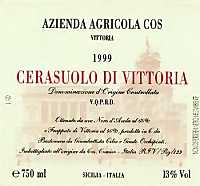
|
|
Cerasuolo di Vittoria 2003 |
|
| COS (Sicily, Italy) | |
| Grapes: Nero d'Avola (60%), Frappato (40%) | |
| Price: € 11.50 | Score: |
| The wine shows a brilliant ruby red color and nuances of ruby red, moderate transparency. The nose denotes intense, clean, pleasing and refined aromas which start with hints of black cherry, blackberry and plum followed by aromas of raspberry, blueberry, carob, violet, tobacco and vanilla. The mouth has good correspondence to the nose, a slightly tannic attack and pleasing crispness, however balanced by alcohol, good body, intense flavors. The finish is persistent with flavors of black cherry, plum and blackberry. The Nero d'Avola grape used for the production of this Cerasuolo di Vittoria ages in cask, whereas Frappato ages in steel tanks. | |
| Food Match: Stewed and braised meat with mushrooms, Roasted meat, Broiled meat and barbecue | |
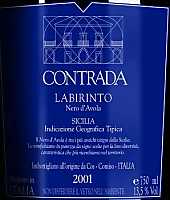
|
|
Contrada Labirinto 2001 |
|
| COS (Sicily, Italy) | |
| Grapes: Nero d'Avola | |
| Price: € 35.00 | Score: |
| This wine shows a brilliant ruby red color and nuances of garnet red, moderate transparency. The nose reveals intense, clean, pleasing and refined aromas which start with hints of black cherry, plum and blackberry followed by aromas of blueberry, toasted, licorice, tobacco, vanilla, carob and menthol. The mouth has good correspondence to the nose, a tannic attack and however balanced by alcohol, good body, intense flavors. The finish is persistent with flavors of plum, black cherry and blackberry. Contrada Labirinto ages for 24 months in barrique, 6 months in steel tanks followed by 12 months of aging in bottle. | |
| Food Match: Roasted meat, Braised and stewed meat with mushrooms, Hard cheese | |
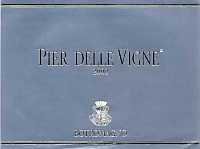
|
|
Pier delle Vigne 2000 |
|
| Botromagno (Apulia, Italy) | |
| Grapes: Aglianico (60%), Montepulciano (40%) | |
| Price: € 10.00 | Score: |
| This wine shows an intense ruby red color and nuances of garnet red, moderate transparency. The nose reveals intense, clean, pleasing and refined aromas which start with hints of plum jam and blackberry jam followed by aromas of raspberry jam, blueberry, carob, tobacco, vanilla, cyclamen, licorice and black pepper. The mouth has good correspondence to the nose, a tannic attack and however balanced by alcohol, good body, intense flavors. The finish is persistent with flavors of plum jam and blackberry jam. Pier delle Vigne ages for at least 18 months in barrique followed by at least 6 months of aging in bottle. | |
| Food Match: Roasted meat, Braised and stewed meat with mushrooms, Hard cheese | |
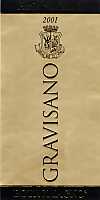
|
|
Gravisano 2001 |
|
| Botromagno (Apulia, Italy) | |
| Grapes: Malvasia Bianca | |
| Price: € 14.00 - 375ml | Score: |
| This wine shows a brilliant amber yellow color and nuances of amber yellow, transparent. The nose reveals intense, clean, pleasing and refined aromas that start with hints of dried fig, honey and raisin followed by aromas of dried apricot, quince jam, peach jam, date, almond, medlar, honey, vanilla and enamel. The mouth has good correspondence to the nose, a sweet attack and pleasing roundness, however balanced by alcohol, good body, intense flavors, agreeable. The finish is persistent with flavors of dried fig, honey, medlar and raisin. Gravisano ferments in barrique. | |
| Food Match: Hard cheese, Almond and dried fruits tarts, Confectionery | |
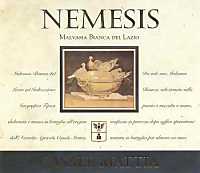
|
|
Nemesis 2004 |
|
| Casale Mattia (Latium, Italy) | |
| Grapes: Malvasia Bianca | |
| Price: € 5.00 | Score: |
| This wine shows a pale straw yellow color and nuances of greenish yellow, very transparent. The nose reveals intense, clean and pleasing aromas that start with hints of hawthorn and apple followed by aromas of broom, almond, pear and plum. The mouth has good correspondence to the nose, a crisp attack and however balanced by alcohol, good body, intense flavors. The finish is persistent with flavors of apple and plum. Nemesis ages in steel tanks. | |
| Food Match: Fish appetizers, Pasta and risotto with fish and vegetables | |

|
|
Frascati Superiore Linea Storica 2004 |
|
| Casale Mattia (Latium, Italy) | |
| Grapes: Malvasia di Candia, Malvasia Bianca, Trebbiano Giallo, Bombino, Bellone | |
| Price: € 10.50 | Score: |
| The wine shows an intense greenish yellow color and nuances of greenish yellow, very transparent. The nose denotes intense, clean, pleasing and refined aromas which start with hints of apple, pear and jasmine followed by aromas of pineapple, hawthorn, broom, almond and plum. The mouth has good correspondence to the nose, a crisp attack and however balanced by alcohol, good body, intense flavors. The finish is persistent with flavors of pear, apple and pineapple. This Frascati ages in steel tanks. | |
| Food Match: Fried fish, Pasta with fish, Roasted fish | |
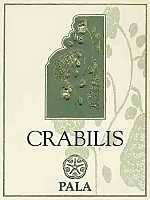
|
|
Vermentino di Sardegna Crabilis 2005 |
|
| Pala (Sardinia, Italy) | |
| Grapes: Vermentino | |
| Price: € 6.00 | Score: |
| The wine shows an intense greenish yellow color and nuances of greenish yellow, very transparent. The nose denotes intense, clean, pleasing and refined aromas which start with hints of peach, pear and pineapple followed by aromas of citrus fruits, litchi, broom, acacia and apple. The mouth has good correspondence to the nose, a crisp attack and however balanced by alcohol, good body, intense flavors, agreeable. The finish is persistent with flavors of peach, pineapple and pear. This Vermentino di Sardegna ages in steel tanks. | |
| Food Match: Fried fish, Risotto with crustaceans and fish, Sauteed fish | |
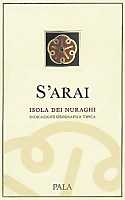
|
|
S'Arai 2002 |
|
| Pala (Sardinia, Italy) | |
| Grapes: Cannonau, Carignano, Barbera, Bovale | |
| Price: € 18.00 | Score: |
| This wine shows a brilliant ruby red color and nuances of garnet red, moderate transparency. The nose reveals intense, clean, pleasing and refined aromas that start with hints of plum and black cherry followed by aromas of blueberry, blackberry, violet, vanilla, tobacco, licorice and carob. The mouth has good correspondence to the nose, a tannic attack and however balanced by alcohol, good body, intense flavors. The finish is persistent with flavors of plum and black cherry. S'Arai ages for 8-10 months in barrique followed by 3-4 months of aging in bottle. | |
| Food Match: Roasted meat, Braised and stewed meat, Hard cheese | |

|
|
Nebbiolo d'Alba Bricco Barone 2003 |
|
| Abbona Marziano (Piedmont, Italy) | |
| Grapes: Nebbiolo | |
| Price: € 9.00 | Score: |
| The wine shows a brilliant ruby red color and nuances of brick red, moderate transparency. The nose reveals intense, clean, pleasing and refined aromas which start with hints of cherry, strawberry and plum followed by aromas of violet, raspberry, rose, vanilla, licorice, cinnamon and rosemary. The mouth has good correspondence to the nose, a tannic attack and pleasing crispness, however balanced by alcohol, full body, intense flavors. The finish is persistent with flavors of cherry, strawberry and plum. This Nebbiolo ages for 12 months in barrique followed by 6 months of aging in bottle. | |
| Food Match: Roasted meat, Braised and stewed meat, Hard cheese | |

|
|
Barolo Pressenda 2001 |
|
| Abbona Marziano (Piedmont, Italy) | |
| Grapes: Nebbiolo | |
| Price: € 26.00 | Score: |
| This Barolo shows a brilliant ruby red color and nuances of brick red, moderate transparency. The nose reveals intense, clean, pleasing, refined and elegant aromas that start with hints of cherry, violet and raspberry followed by aromas of plum, rose, cyclamen, vanilla, tobacco, licorice, strawberry jam, cinnamon, cocoa, cigar box, mace and menthol. The mouth has very good correspondence to the nose, a tannic attack and pleasing crispness, however balanced by alcohol, full body, intense flavors. The finish is persistent with flavors of cherry, raspberry and plum. A well made wine. This Barolo ages for 12 months in barrique followed by 18 months of aging in cask. | |
| Food Match: Game, Roasted meat, Braised and stewed meat, Hard cheese | |
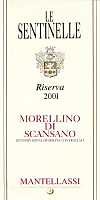
|
|
Morellino di Scansano Riserva Le Sentinelle 2001 |
|
| Fattoria Mantellassi (Tuscany, Italy) | |
| Grapes: Sangiovese (85%), Alicante (15%) | |
| Price: € 14.00 | Score: |
| The wine shows an intense ruby red color and nuances of garnet red, little transparency. The nose denotes intense, clean, pleasing and refined aromas that start with hints of black cherry, blackberry and plum followed by aromas of blueberry, violet, vanilla, tobacco, licorice, chocolate and hints of menthol. The mouth has good correspondence to the nose, a tannic attack and pleasing crispness, however balanced by alcohol, good body, intense flavors. The finish is persistent with flavors of black cherry and plum. This Morellino di Scansano ages for 20 months in barrique. | |
| Food Match: Roasted meat, Braised and stewed meat with mushrooms, Hard cheese | |

|
|
Querciolaia 2002 |
|
| Fattoria Mantellassi (Tuscany, Italy) | |
| Grapes: Alicante | |
| Price: € 16.00 | Score: |
| Querciolaia shows an intense ruby red color and nuances of garnet red, little transparency. The nose reveals intense, clean, pleasing and refined aromas which start with hints of black cherry and plum followed by aromas of blueberry, blackberry, peanut butter, carob, tobacco, vanilla and pink pepper. The mouth has good correspondence to the nose, a tannic attack and however balanced by alcohol, good body, intense flavors. The finish is persistent with flavors of black cherry, plum and blueberry. This wine ages for 13-16 months in barrique. | |
| Food Match: Roasted meat, Braised and stewed meat with mushrooms, Hard cheese | |
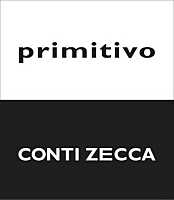
|
|
Primitivo 2003 |
|
| Conti Zecca (Apulia, Italy) | |
| Grapes: Primitivo (85%) | |
| Price: € 9.15 | Score: |
| This wine shows an intense ruby red color and nuances of ruby red, little transparency. The nose reveals intense, clean, pleasing and refined aromas which start with hints of black cherry, plum and blackberry followed by aromas of blueberry, vanilla, tobacco, licorice, coffee, carob and anise. The mouth has good correspondence to the nose, a slightly tannic attack and however balanced by alcohol, good body, intense flavors. The finish is persistent with flavors of black cherry, plum and blackberry. This wine ages for 12 months in barrique. | |
| Food Match: Broiled meat and barbecue, Roasted meat, Stewed and braised meat | |
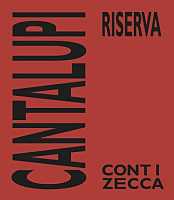
|
|
Salice Salentino Rosso Riserva Cantalupi 2002 |
|
| Conti Zecca (Apulia, Italy) | |
| Grapes: Negroamaro (80%), Malvasia Nera (20%) | |
| Price: € 8.75 | Score: |
| The wine shows an intense ruby red color and nuances of garnet red, little transparency. The nose denotes intense, clean, pleasing and refined aromas that start with hints of plum and blackberry followed by aromas of black cherry, raspberry, violet, vanilla, tobacco, licorice and carob. The mouth has good correspondence to the nose, a slightly tannic attack and however balanced by alcohol, good body, intense flavors. The finish is persistent with flavors of black cherry and blackberry. Salice Salentino Cantalupi ages for at least 12 months in cask. | |
| Food Match: Broiled meat and barbecue, Roasted meat, Hard cheese | |
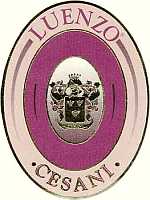
|
|
Luenzo 2002 |
|
| Cesani (Tuscany, Italy) | |
| Grapes: Sangiovese (90%), Colorino (10%) | |
| Price: € 20.00 | Score: |
| Luenzo shows an intense ruby red color and nuances of ruby red, little transparency. The nose reveals intense, clean, pleasing and refined aromas that start with hints of black cherry, plum and violet followed by aromas of blueberry, vanilla, raspberry, carob, tobacco and cardamom. The mouth has good correspondence to the nose, a tannic attack and pleasing crispness, however balanced by alcohol, good body, intense flavors. The finish is persistent with flavors of black cherry, plum and raspberry. This wine ages for 16 months in barrique. | |
| Food Match: Roasted meat, Braised and stewed meat with mushrooms, Hard cheese | |
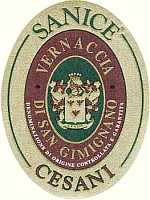
|
|
Vernaccia di San Gimignano Sanice 2003 |
|
| Cesani (Tuscany, Italy) | |
| Grapes: Vernaccia di San Gimignano | |
| Price: € 15.00 | Score: |
| This wine shows an intense golden yellow color and nuances of golden yellow, very transparent. The nose reveals intense, clean, pleasing and refined aromas which start with hints of peach, plum and apple followed by aromas of pineapple, hazelnut, vanilla, praline, peach jam and peanut butter. The mouth has good correspondence to the nose, a crisp attack and however balanced by alcohol, pleasing smoothness, good body, intense flavors. The finish is persistent with flavors of apple, pineapple and plum. Part of this wine ages for 6 months in barrique. | |
| Food Match: Stuffed pasta, Roasted fish, Roasted white meat, Mushrooms soups | |
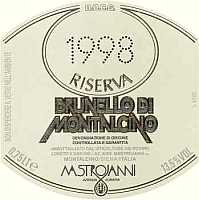
|
|
Brunello di Montalcino Riserva 1998 |
|
| Mastrojanni (Tuscany, Italy) | |
| Grapes: Sangiovese Grosso | |
| Price: $55.00 | Score: |
| This wine shows a brilliant ruby red color and nuances of brick red, moderate transparency. The nose reveals intense, clean, pleasing, refined and elegant aromas which start with hints of prune, black cherry and blueberry jam followed by aromas of blackberry jam, dried violet, vanilla, dried rose, tobacco, licorice, chocolate, cinnamon, mace and menthol. The mouth has good correspondence to the nose, a tannic attack and pleasing crispness, however balanced by alcohol, full body, intense flavors. The finish is persistent with flavors of prune, black cherry and blueberry jam. A well made wine. This Brunello di Montalcino Riserva ages for 42 months in cask followed by about 12 months of aging in bottle. | |
| Food Match: Game, Roasted meat, Braised and stewed meat, Hard cheese | |
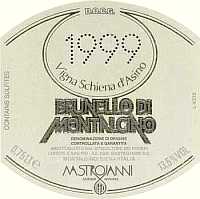
|
|
Brunello di Montalcino Vigna Schiena d'Asino 1999 |
|
| Mastrojanni (Tuscany, Italy) | |
| Grapes: Sangiovese Grosso | |
| Price: $75.00 | Score: |
| This Brunello di Montalcino shows a brilliant ruby red color and nuances of garnet red, little transparency. The nose reveals intense, clean, pleasing, refined and elegant aromas that start with hints of black cherry, plum and blackberry followed by aromas of violet, blueberry, rose, vanilla, tobacco, licorice, cocoa, cinnamon, pink pepper and menthol. The mouth has good correspondence to the nose, a tannic attack and pleasing crispness, however balanced by alcohol, full body, intense flavors, agreeable smoothness. The finish is very persistent with long flavors of plum, black cherry and blackberry. A well made wine. This Brunello di Montalcino ages for about 42 months in cask followed by about 8-9 months of aging in bottle. | |
| Food Match: Game, Roasted meat, Stewed and braised meat, Hard cheese | |
|
||||||||
|
DiWineTaste Polls
|
| |||||||
Privacy Policy | |||||||


| Copyright © 2002-2024 Antonello Biancalana, DiWineTaste - All rights reserved |
| All rights reserved under international copyright conventions. No part of this publication and of this WEB site may be
reproduced or utilized in any form or by any means, electronic or mechanical, without permission in writing from DiWineTaste. |